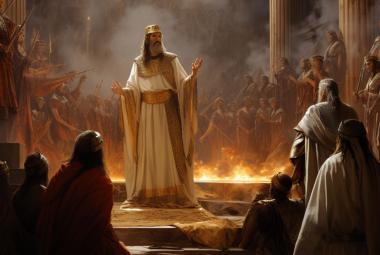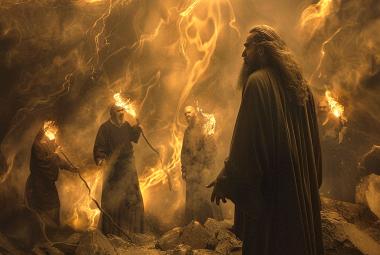Q: Easter this year fell on March 27, 2005. Passover falls on April 23-24, 2005. Why is there an entire month between Easter and Passover this year? Aren't they theoretically connected?
Easter is an annual festival commemorating the resurrection of Jesus Christ and remains the principal feast of the Christian year. It is celebrated on a Sunday on varying dates between March 22 and April 25 and seems to be a moving target. The dates of several other ecclesiastical festivals, extending over a period between Septuagesima Sunday (the ninth Sunday before Easter) and the first Sunday of Advent, are fixed in relation to the date of Easter.
Easter, however, actually emanates from earlier pagan traditions.
Astarte is the Greek and Roman name of Ashtoreth, the supreme female divinity of the Phoenician nation, the goddess of love and fruitfulness. [Like that of Baal, the corresponding male divinity, the name is frequently found in the earlier books of the Old Testament in the plural form Ashtaroth; not until the time of King Solomon of Israel (10th century B.C.) did the singular form Ashtoreth occur.] The Babylonian and Assyrian counterpart of Astarte was Ishtar, from which has evolved Easter. (The legends regarding the Golden Egg of Astarte and the fertility symbol of the rabbit have yielded the peculiar traditions involving rabbits that lay eggs!)
The Christian Easter
The word Easter appears in the KJV in the Book of Acts (Acts 12:4), but the Greek word πάσχα pascha, actually refers to Passover, and is so corrected in most modern renderings. Christ was crucified on Passover, which fell on the 14th day in the month of Nisan, the first month of their religious year (Ex 12:1). Since their calendar was lunar and they determined their months (moonths) by the new moon, Passover - the 14th of Nisan - fell from year to year on different days of the week.
Jesus rose on the 3rd day following Passover, appropriately on the Feast of Firstfruits (the morning after the Sabbath after Passover, cf. Lev 23:9-14). This was always on a Sunday, irrespective of the day of the week of Passover. Thus, Christians have traditionally celebrated His resurrection on Sunday. But which one?
A Sidereal Easter
When Constantine convoked the Council of Nicaea in A.D. 325, they unanimously ruled that the Easter festival should be celebrated throughout the Christian world on the first Sunday after the full moon following the vernal equinox; and that if the full moon should occur on a Sunday and thereby coincide with the Passover festival, Easter should be commemorated on the Sunday following. This was Constantine's shrewd means toward uniting his empire, which included several different groups of sun-worshipers, along with the growing Christian sect which he had also legalized.
The Problems Continue
The Council of Nicaea also decided that the calendar date of Easter was to be calculated at Alexandria, then the principal astronomical center of the world. The accurate determination of the date, however, proved an impossible task in view of the limited knowledge of 4th-century astronomy. The principal astronomical problem involved was the discrepancy between the solar year and the lunar year, called the epact. Their chief calendric problem was the gradually increasing discrepancy between the true astronomical (sidereal) year and the Julian calendar then in use.
Various ways of fixing the date of the feast tried by the church proved unsatisfactory, and Easter was celebrated on different dates in different parts of the world. In 387, for example, the dates of Easter in France and Egypt were 35 days apart. About 465, the church adopted a system of calculation proposed by the astronomer Victorinus, who had been commissioned by Pope Hilarius to reform the calendar and fix the date of Easter. Elements of his method are still in use, although the Scythian monk Dionysius Exiguus made significant adjustments to the Easter cycle in the 6th century. Refusal of the British and Celtic Christian churches to adopt the proposed changes led to a bitter dispute between them and Rome in the 7th century.
The Gregorian Reform
Reform of the Julian calendar in 1582 by Pope Gregory XIII, through adoption of the Gregorian calendar, eliminated much of the difficulty in fixing the date of Easter and in arranging the ecclesiastical year. Since 1752, when the Gregorian calendar was also adopted in Great Britain and Ireland, Easter has been celebrated on the same day in the Western part of the Christian world. The Eastern churches, however, which did not adopt the Gregorian calendar, commemorate Easter on a Sunday either preceding or following the date observed in the West. Occasionally the dates coincide; the most recent times were in 1865 and 1963.
Because the Easter holiday affects a varied number of secular affairs in many countries, it has long been urged as a matter of convenience that the movable dates of this festival be either narrowed in range, or replaced by a fixed date, in the manner of Christmas. In 1923 the problem was referred to the Holy See, which has found no canonical objection to the proposed reform. In 1928 the British Parliament enacted a measure allowing the Church of England to commemorate Easter on the first Sunday after the second Saturday in April.
Ancient Calendar Changes
All ancient calendars appear to have been initially based on a 360-day year: the Assyrians, Chaldeans, Egyptians, Hebrews, Persians, Greeks, Phoenicians, Chinese, Mayans, Hindus, Carthaginians, Etruscans, and Teutons all had calendars based on a 360-day year; typically, twelve 30-day months. In ancient Chaldea, the calendar was based on a 360-day year. It is from this Babylonian tradition that we have 360 degrees in a circle, 60 minutes to an hour, 60 seconds in each minute, etc. It is also significant that the Biblical year is also based on a 360-day year reckoning.1 This critical insight unlocks several incredible prophecies which the reader is urged to discover - in particular, the remarkable 70 Weeks prophecy of Daniel 9, which is undoubtedly the most amazing passage in the Bible.2 However, all calendars seem to have changed after 701 B.C. In 701 B.C., Numa Pompilius, the second King of Rome, reorganized their original calendar of 360 days per year by adding five days per year.
When others were adding extra days to their 360-day calendars in their attempt to reconcile the lunar and sidereal differences, King Hezekiah (a contemporary of Numa Pompilius) adopted an entirely different (and rather strange) approach. He added an additional month during seven leap years on a 19-year cycle: the 3rd, 6th, 8th, 11th, 14th, 17th, and 19th years are leap years, where a second month Adar (Adar II) is added.3
This year the Jewish leap year, with its extra month of Adar, causes the additional interval between Passover and the traditional Easter on our calendar.
Martian Interference?
Why was any change necessary after 701 B.C.? What happened to affect all the calendars after that year? The Roman year began with March, the month named after Mars. (They later reorganized their calendar in 364 B.C. to begin on January 1st.) Most of the early cultures organized their calendars around either March or October. Why?
There is some evidence that changes caused by orbital resonance between the orbits of Earth and Mars may have been the cause. The recent space age discovery of orbital resonance - the tendency of orbits to synchronize on a multiple of one another - has led to a fascinating conjecture that the orbits of the Earth and the Planet Mars were once on resonant orbits of 360 days and 720 days, respectively. A computer analysis has suggested that this could yield orbital interactions that would include a near pass-by on a multiple of 54 years, and that this would occur on either March 25th or October 25th. Such near pass-bys would transfer energy, altering the orbits of each.
In near proximity, such pass-bys would be accompanied by meteors, severe land tides, earthquakes, etc., and this would help explain why all the ancient cultures were so terrified by the Planet Mars4 and why calendars tended to reflect either March or October.5 A series of such pass-bys may have accompanied several of the catastrophes of ancient history, including the famous long day of Joshua and several other Biblical episodes.6
Stability appears to have been attained during the last near pass-by in 701 B.C., resulting in Earths and Mars present orbits of 365 1/4 days and 687 days, respectively. Provocative, but where's the evidence?
A Swift Insight
This remarkable conjecture, that Mars made pass-bys near the Earth, would seem to be corroborated by Jonathan Swift (1667-1745) in his famous fantasy known as Gulliver's Travels. In his third voyage, Gulliver visits the land of Laputa, where the astronomers brag that they know all about the two moons of Mars.7 Their highly detailed description includes the size, the rotation, the revolutions, etc., of each of the two moons.
What makes this particular allusion so provocative is that the two moons of Mars were not discovered by astronomers until 151 years after Swifts publication of Gulliver's Travels in 1726. It was in 1877 that Asaph Hall, using a new telescope at the U.S. Naval Observatory, shocked the astronomical world by discovering the two moons of Mars.
What makes the two moons so difficult to see is that they are only about 8 miles in diameter and have an albedo (reflectivity) of only 3%. They are the darkest objects in the solar system: they are almost black. The two moons are also unique in their rotations and one of them is the only object in the solar system that orbits in reverse.8 For Swift to have guessed these details correctly is absurd. Yet the telescopes of his day were inadequate to have actually seen these objects. But then how could he have known what the astronomers of his day did not? Swift, in order to embroider his satirical fiction, apparently drew upon ancient records he probably assumed were merely legends, not realizing that they were actually eye witness accounts of ancient sightings when Mars was close enough for the two moons of Mars to be viewed with the naked eye!
Other Implications
The possibility that the Planet Mars interacted with the Planet Earth may have implications beyond simply ancient perturbations of our calendar and even the subsequent veneration of October 31th as Halloween. It has been widely noted that the ancient Stonehenge monument in England and the Great Pyramid at Cairo also have astronomical implications.9 The geometric and mathematical mysteries of these fabled monuments have been the subject of much conjecture. Cairo was founded on August 5, A.D. 969, by conquering Fatimid armies and named, Al Kahira, after Mars. Why?
There's ample opportunity for further research in these fascinating areas. However, your most fruitful investigations will be to probe the insights of the Jewish calendar: it is a virtual catechism. God has appointed the Moyadim for our learning and God always rewards the diligent!
Notes:
- Genesis 7:24; 8:3,4, etc. In Revelation, 42 months = 3 1/2 years = 1260 days, etc.
- See our briefing pack, The 70 Weeks of Daniel, or our Expositional Commentary on Daniel.
- Arthur Spier, The Comprehensive Hebrew Calendar, Feldheim Publishers, Jerusalem, 1986.
- 2 Kings 17:16; 21:3-5.
- Note also Isaiah 24:1, 19, 20.
- Donald W. Patten, Ronald R. Hatch, and Loren C. Steinhauer, The Long Day of Joshua, Pacific Meridian Publishing Co., Seattle, WA, 1973. See also our Expositional Commentary on Joshua.
- Jonathan Swift, Gulliver's Travels, 1726, Part III, Chapter 3.
- Deimos and Phobos = Panic and Fear in Greek. Phobos is 1/100 width of our moon (8 miles diameter); rotates 7h39m; appears to rise in W: unique in our solar system. Deimos (30h18m) appears almost synchronous: 24h37m.
- Detailed in our briefing pack, Monuments: Sacred or Profane?







